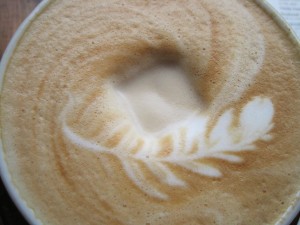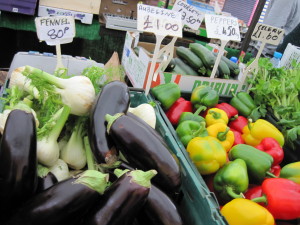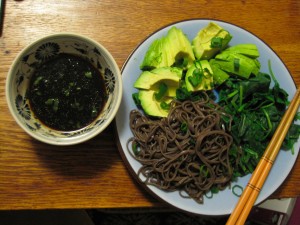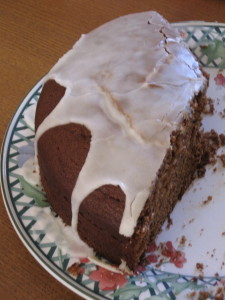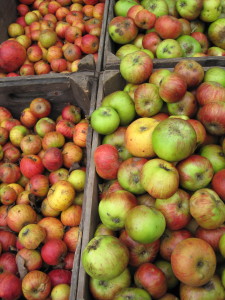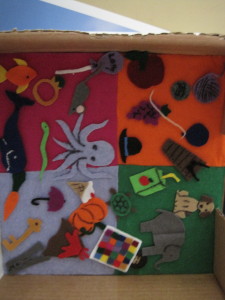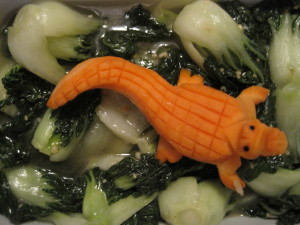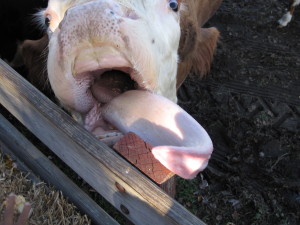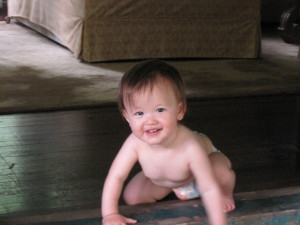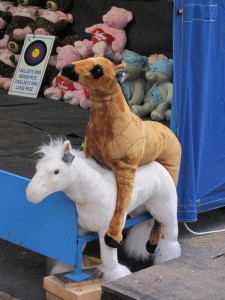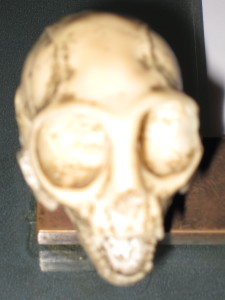In Ann Arbor I think about food and poke into corners, physical and virtual. I poked into my photo library with a head full of A. J. Leibling’s “Between Meals,” and now I share food pictures.
Monthly Archives: December 2010
3:00 am Checklist for What Makes a Good Recipe
To judge if a recipe is really excellently written, check to see if it meets all of the following criteria:
- Includes how many people it serves, clearly mentioned at the beginning.
- Includes an estimate for how long it will take, including important things like if something has to marinate overnight or set for four hours that it would be nice to know in advance.
- Includes an easily accessible list of ingredients, split up if the recipe has multiple parts (like, a dish plus a sauce).
- Includes a list of equipment, especially if there’s something sort of esoteric, or that the recipe will be impossible to make without the use of. Like a foodmill, or cheesecloth, or a bundt pan.
-
The steps are written in the order in which they are to be performed, as precisely as possible.* If the oven needs to be preheated, then preheating the oven is at least part of the first step.
- The steps are divided carefully and logically. Each numbered step may have several operations; otherwise you wind up with a 17 step recipe for pasta, and that gets daunting. Things should be chunked together via time and similarity of motion.
- Includes general cook times and visual descriptors in steps. Flames run hot, flames run cold, people forget to set timers. “Cook for 2 minutes” is not very useful, and “cook until golden” is only a little better. “Cook for about two minutes, until golden brown and fragrant” is better than the sum of its parts.
- Includes ALL OTHER NECESSARY INFORMATION. Has every ingredient and every piece of equipment listed at the beginning been accounted for? Is it noted whether the flame should be low, medium, or high? If it should be adjusted, and if so, when? Is it noted that the will dish look unexpectedly wet, dry, dark, light, green, or cheesy? Is there a precise time at which one should turn, poke, shake or stir things to keep everything ready? All of that information should be included in the recipe.
- Pictures are always nice.
- So is a little character, y’know. Cooking is fun. Recipes can be, too.
If you know how to cook, you won’t need your recipes to have all of these things. The best cooks I have use recipes books that are just lists of ingredients and quantities, with nary a procedure around. In my own cooking, unless I’m cooking from an author or cook I really trust and admire, I usually find several recipes for a given dish and choose the bits I like best from each of them.
But I always think that maybe, if every recipe you came across had all of these qualities, I wouldn’t do all that. I’d just pick one, get the stuff, trust it, and go.
* Of course, everybody should read the whole recipe before they start cooking, which makes this much less important. But not everybody does rtwrbtsc, and it improves the Universe to be kind to those who go forth into their culinary ventures in a state of bold and confident ignorance.
Meg Murry’s House
The rain is dashing at the windows and the wind is picking at the skylight glass and making it moan, and howling around house. Every once in a while I can feel the whole apartment sway.
And if I don’t pay close attention I can almost believe that if I open the door, I will find the dark and narrow attic staircase, and if I head downstairs Charles Wallace will be eating a sandwich, a double pot of milk warming on the stove for cocoa.
I can almost believe in a black dog named Fortinbras and a beautiful mother with violet eyes.
Clementine Seeds
I was told that clementines
do not bear seeds.
So this most recent box
– Clementines, you know, are typically shipped
– in wooden boxes
– (made of boxwood, I shouldn’t wonder)
has me befuddled.
First I crunched through the seeds,
then I spit them out and lay them,
glistening wet
in the aromatic cradle of the fruit’s discarded skin.
What is the meaning of this?
I asked the Internet.
– Wonder of wonders
– Futurism at its best.
And the Internet told me
that the culprit
was cross-pollination.
There was a lawsuit!
Orchard keepers vs. Beekeepers.
– Keep your insects
– away from our mandarin-orange-subspecies!
Clearly it wasn’t the bees fault;
who can blame a bee for doing what bees do?
– Especially now that they’re disappearing.
– (That would be rude!)
So blame the keepers, and take them to court
Maybe the orchards are now more sacrosanct.
Or maybe the orchard-keepers’ pockets better lined
But I think it must go deeper than that.
If you’re a fruit that has no seeds,
then you’re a fruit that knows there will never be another fruit
just precisely like you.
You’re a fruit that cannot pass along its genes.
– A neuter fruit
– A eunuch fruit
And even the gentle clementine would not want to be that!
I think that clementine seeds are a sign
of the persistence of life.
Bees will get into orchards. This is what bees do.
The will do their little bee dances on your
mandarin-orange-subspecies flowers
and Mr. Orchard-Keeper
– (or Ms)
there is nothing you can do about it.
The clementine wants to evolve
and the bees want to help it.
Who are we to stand in the way of this,
the greatest of natural functions,
just so that we can enjoy
a seed-free fruit?
Photo Essay: Things I Find Cute
Here are some things that I think are cute. Don’t you agree? (Do you?)
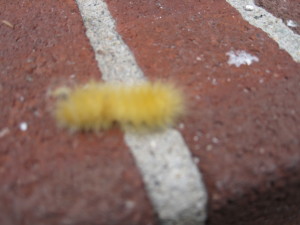
This caterpillar (ambient ball of fluff).
A pile of baby quails.
Small objects made of felt.
Mr. Carrot Crocodile
The calf that tried to eat me.
Talia Adelina Woo
Cookies that look like owls.
Stuffed animals in love.
The skulls of tiny primates.
Neil Gaiman on Stories
“Stories that matter have ends. Anything that matters ends. It’s the end that gives it a meaning. And the joy, for me, of narrative fiction is you get to pick your beginning and you get to pick your end, and that imposes form and shape on the material between those two things. And that gives you a story. ”
-Neil Gaiman
Reading My Mother’s Books
So I’m reading “Gaudy Night” by Dorothy Sayers. It’s a technically one of the Lord Peter Wimsey mysteries but this one is really much more about his nay-saying paramour Harriet Vane, and about the early days of college education for women (written in the mid 1930’s) and feminism and lunacy.
I love it. I had to rewrite the first sentence of this because it came out as sounding like pre-war English literature.
It’s my mother’s book. My mother writes in her books. Little lines in the margin by passages she thinks are important. Sometimes notes in the front material of partial quotes with page numbers. And when something is really important, I guess, exclamation points and underscoring.
The setting is Shrewsbury College, an early women’s college at Oxford, always on the edge of social scandal just for existing, but a place of spinsterly learning and devotion to intellect. Ms. Harriet Vane graduated from there some 10 years prior, Lord Peter Wimsey from a male Oxford college some 10 years before that.
Miss Edwards, the science tutor, is speaking to Lord Peter and the assembled dons of the college, as Miss Barton (who’s subject I don’t remember) has just “returned to her contention that her social principles were opposed to violence of every description”:
“Bosh!” said Miss Edwards, “You can’t carry through any principle without doing violence to somebody. Either directly or indirectly. Every time you disturb the balance of nature you let in violence. And if you leave nature alone you get violence in any case. I quite agree that murderers shouldn’t be hanged — it’s wasteful and unkind. But I don’t agree that they should be comfortably fed and housed while decent people go short. Economically speaking, they should be used for laboratory experiments.”
My mother put two exclamation points in bold blue pen next to this passage, but she’s not in favor of human experimentation, that I can tell. The only underlined words are ‘it’s wasteful and unkind.’
This is my mother. This is my upbringing. Capital punishment is wrong, pure and simple – because it’s wasteful and unkind.
Ode to a Swede
How unfair it is
That anyone should be so beautiful
So graceful and unplanned
So soft spoke and
Surprisingly
Approachable
How terrible that one such as myself
Admittedly brazen
Approaching fearless
Should be reduced to giggling avoidance
Of the mere thought
Of the mere inquiry
Of the mere possibility
Of a mere dance
You will be missed, Stranger
Off wandering the continent
We hardly knew ye
But we were looking
From across the floor
We were a little stunned
Even into silence
Later into laughter
At our own silliness, how could we have worried
So graceful and so lovely
But just a human, after all
You will be missed

